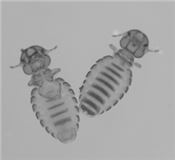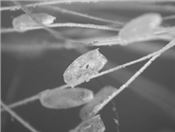Sucking And Biting Lice
DR. LEE TOWNSEND
LEXINGTON, KY.
Lice are small, wingless, flat-bodied insects with legs modified for grasping hair shafts. They are generally host-specific. For example, cattle lice will not survive for long on swine. They are obligate parasites because they must have blood meals to develop and produce eggs (nits). Lice cannot survive off of their host for more than a few days, especially during the winter.
Irritation from bites of sucking lice and sensations from frequent movement of biting lice make animals restless. Gross signs of infestation include excessive rubbing against fence post and structures and loss of clumps of hair. Raw spots may develop as animals frequently rub or groom irritated areas. In addition, the hair coat can take on a matted appearance.
Sucking lice, with their narrow, pointed heads, are blood feeders. Crushed lice, their tarry feces, and serum from wounds can give heavily infested animals a greasy appearance. Biting lice feed by scraping material from the dermis and base of hairs. Skin reaction may cause excessive hair loss.
It is difficult to quantify direct economic and health impacts from infestations of biting and sucking lice. However, it appears that an average of 10 or more per square inch, at certain locations on the body, are necessary to affect weight gains significantly. Moderate to heavy infestations add to the stresses of winter, shipping, inadequate nutrition, internal parasites, and disease. In addition, blood loss to sucking lice can produce anemia. When abundant, biting and sucking lice can contribute to general unthriftiness of animals and may prolong recovery from disease.
Biting and sucking lice are most abundant on animals during the winter. They are transferred by direct contact as cattle bunch in response to cold or crowded conditions. Reduced light intensity of winter months is thought to play a significant role in increase in louse numbers, as well.
Lice numbers on animals generally decrease significantly during the summer. However, the some of the insects survive the winter on susceptible animals. An estimated 1 percent to 2 percent of a herd may be chronically infested. Older cows with compromised immunity can be a source, as well as or bulls with longer, thicker hair coats and heavy muscles that reduce effective self-grooming. They serve as reservoirs of lice that rapidly transfer to the rest of the herd during the fall and early winter.
Monitoring lice infestations
Close examination of the hair coat is important when monitoring for lice and confirming the problem. Mange, ringworm, or other skin conditions may cause similar symptoms and behavior and their management programs are quite different. Correct identification is the key to making sound decisions.
Lice have preferred feeding sites where they can be found when numbers are low. Knowing these tendencies makes checking for lice more efficient. Sucking lice are not very mobile, they tend to be in densely-packed clumps that from a distance an appear as dark spots. These lice are not easily disturbed during examination. Biting lice do not form clumps. They are active and move readily if disturbed. In severe infestations results, lice are forced to more to parts of the body that they normally would not prefer.
Life cycle
All stages of the louse life cycle occur on animals. Lice eggs, or nits, are glued singly to hairs and hatch in about 2 weeks. The nymphs, or immature stages, resemble adults but are smaller. Nymphs molt 3 times as they develop, reaching the adult stage in about 3 weeks. Adults continue to feed for 2- to 3-weeks. Females produce about an egg per day until they die.
Examining for cattle lice
Prevent problems by keeping newly-purchased animals separate until they can be examined carefully or treated preventively before turning them in with herd. Light infestations are easy to overlook so checking in preferred sites on the animal is important.
Randomly check about 5 percent of the animals to confirm and quantify louse infestations. Be sure to check animals that look “lousy”, those with rough coats or signs of rubbing. Look first for lice and small, oblong white to yellow nits (eggs) attached to hairs. Lice feed head down toward the skin. Chewing lice will move about while sucking lice remain in place.
After an overall look, part the hair and examine 5, 1-square inch areas on the face, dewlap, neck, and back. Origin of the animals can affect pest problems. Examine tail heads of these animals for the tail louse. Write down the numbers you find to help assess the infestation and calculate the average per square inch.
Infestation Lice / sq inch
Light 1 to 10
Moderate 11 to 20
Heavy 21 to 50
Severe More than 50
Catching light to moderate infestations in late fall to early winter allows time to treat before lice numbers reach levels that stress animals and affect productivity or herd health. Louse infestations in late winter probably already have had their impact and numbers will drop naturally with the return of warm weather. Also, products used for spring de-worming may help with control. Animals with very high louse populations should be noted. They may be serving as reservoirs during the summer and may be considered for culling.
Managing cattle lice
A sound animal health program is the foundation of pest management. Lice usually are suppressed in herds that are routinely treated with most dewormers (doramectin, eprinomectin, ivomectin, or moxidectin). Insecticides used to control horn flies and face flies also reduce louse numbers. However, lice may survive in protected areas on some animals or on animals that were under-treated or missed..
It is important to know the use history of these systemic products because winter applications can trigger an adverse reaction in cattle that were not treated for cattle grubs before the annual cut-off date (October 31 for animals that were in Kentucky during the summer). See the product label for details.
If lice infestations are detected after the cutoff date and the history of cattle grub treatment is not known, then use a non-systemic insecticide. Products containing l-cyhalothrin, cyfluthrin, or permethrin are widely available. Application options include pour-ons, dust bags, and oilers. Check the label for information on re-treatment interval, a second application may be recommended to kill lice that were in the nit stage when the first treatment was made. ∆
DR. LEE TOWNSEND: Extension Entomologist, University of Kentucky

Figure 1. Bottom (left) and top view (right) of biting lice.
Note the wide head, boxy head. Sucking lice have narrow, pointed heads.
Photos: Lee Townsend, UK

Figure 2. Louse eggs (nits) attached to hairs. Clear, center nit with flat top
indicates that hatch has occurred. The white nit in the upper right
corner has not hatched.